![]()
![]()
![]()
Use LEFT and RIGHT arrow keys to navigate between flashcards;
Use UP and DOWN arrow keys to flip the card;
H to show hint;
A reads text to speech;
23 Cards in this Set
- Front
- Back
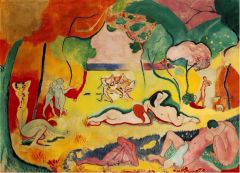
|
Artist: Matisse Title: LeBonheur du Vivre (The Joy of Life) Year: 1905-06 Medium: oil on canvas -arrangement of figures and trees in sinuous, undulating lines reminiscent of contemporary Art Nouveau design -mood of sensual languor -Yet the figure groups are deployed as separate vignettes, isolated from one another spatially as well as by their differing colors and contradictory scales. -fishermen dancing motif -odalisque figures: elegant, sensual, passionate -dreamy -pan piping to sheep -sex: suggestive, not describing -yellow: spiritual -red: carnal and sexual -wild, vibrant colors with classical themes |
|
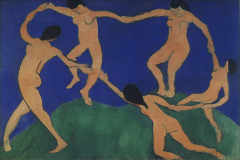
|
Artist: Matisse Title: Dance I Year: 1909 Medium: oil on canvas - Matisse boldly outlined large-scale figures and isolated them against a ground of intense color - Greek vase painting or peasant dances - the colors have been limited to an intense green for the earth, an equally intense blue for the sky, and brick-red for the figures, which are sealed into the foreground by the color areas of sky and ground, and by their proximity to the framing edge and their great size within the canvas - 3 elements: earth, sky, figures, focused only on the dance - transcend mortality, ecstatic spirituality - everything fades away in the union of dance - circle is broken: suggests fragility and difficulty transcending -their bodies fail them -evolved to more local color |
|

|
Artist: Brancusi Title: Bird in Space Year: 1925 Medium: marble, stone, wood -trajectory vapor trail of a bird in flight -wood: take off of bird, earth and trees -everything is progressively simplified -These bases augment the sense of soaring verticality of the bird sculptures. In addition, they serve as transitions between the mundane physical world and the spiritual realm of the bird, for Brancusi sought a mystical fusion of the disembodied light-reflecting surfaces of polished marble or bronze and the solid, earthbound mass of wood. |
|
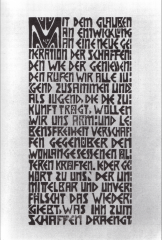
|
Artist: Kirchner Title: Die Brucke Manifesto Year: 1906 Medium: woodcut -woodcut, oldest forms of graphic art -mass of printing looks archaic -combination of ancient and modern type -the "bridge" between the modern and very old |
|
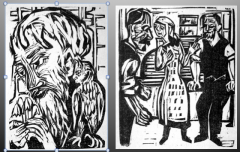
|
Artist: Kirchner Title: Man with a Parrot and The Rivals Year: 1923 Medium: woodcut -highly stylized -wedge-shaped incisions created a testosterone-filled tension -or anxiety -medium used to suggest inward state of man's mind |
|
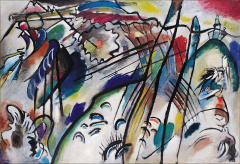
|
Artist: Kandinsky Title: Improvisation 2 Year: 1912 Medium: oil on canvas -titles derived from music -far from recognizable forms -vague landscapes -improvisation of color and line -image free art form that spoke directly to the senses -high-keyed color of the Fauves -still employing a pictorial vocabulary filled with standing figures, riders on horseback, and onion-domed churches, but they are now highly abstracted forms in the midst of a tumultuous, heaving landscape of mountains and trees |
|
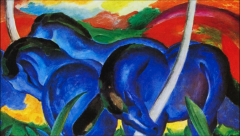
|
Artist: Marc Title: The Large Blue Horses Year: 1911 Medium: oil on canvas -spiritual harmony and purity in nature - emblem of innocence -people are corrupt and cannot be integrated into nature like the horses - blue horses fleshed out sculpturally from the equally vivid reds, greens, and yellows of the landscape -close-up view, with the bodies of the horses filling most of the canvas -The horizon line is high, so that the curves of the red hills repeat the lines of the horses’ curving flanks -no real spatial differentiation between creatures and environment - blue as a masculine principle, robust and spiritual -yellow as a feminine principle, gentle, serene, and sensual -red as matter, brutal and heavy -only animals are assimilated harmoniously into nature—never humans |
|
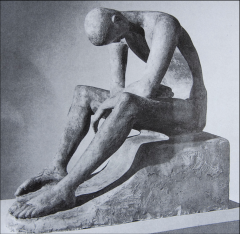
|
Artist: Lehmbruck Title: Seated Youth Year: 1917 Medium: composite plaster -loss of a friend in war -concave emptiness in torso -a void -extreme elongation to convey a sense of contemplation and withdrawal. - mood of dejection and loss -long, angular limbs, penetrated by space, and exploits for expressive ends the abstract organization of solids and voids |
|
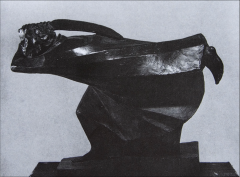
|
Artist: Barlach Title: The Avenger Year: 1914 Medium: bronze -sweeping power -traditional material, non traditional pose -used the human body to depict expression -garments to help express his themes -force of the man’s forward movement is emphasized through the work’s horizontal orientation, its slanted base, and the way the cloak flows back against the figure in diagonal folds |
|
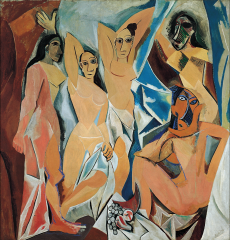
|
Artist: Picasso Title: Les Demoiselles d’Avignon Year: 1907 Medium: oil on canvas -prostitutes -confrontational -Egyptian, ancient Spain, african masks -angular, contorted shapes -angular, shards of space -orientalism (male construct), women as dangerous, exotic creatures -crudely flattened and simplified, reduced to a series of interlocking, angular shapes. -riddled with deliberately disorienting and contradictory points of view -The viewer looks down upon the table at the bottom of the canvas, but encounters the nudes head-on. Eyes are presented full face, while noses are in profile. The seated figure at the lower right faces her cohorts but manages to turn her head 180 degrees to address the viewer. The two central figures offer themselves up for visual consumption by assuming classic Venus poses, while their companion to the left strides into the composition like a fierce Egyptian statue. All of the prostitutes stare grimly ahead, with emotions seemingly as hardened as the knife-edge forms themselves. -harshly painted masks that substitute for faces on the two figures at the right. -reflects the artist’s morbid conflation of sex and death and his characteristically misogynistic view of women as the carriers of life-threatening disease. |
|
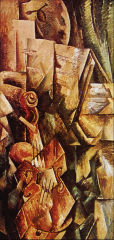
|
Artist: Braque Title: Violin and Palette Year: 1909 Medium: oil on canvas -top>down; recognizable>more abstract -breaking the object apart -duration: perceiving something differently the longer we look at it -simultaneity: the condition of seeing things from several different angles -analytic cubism: taking apart -objects inhabit a shallow, highly ambiguous space. -certain forms are rendered naturalistically but others are broken up into tightly woven facets that open into the surrounding void. -interstices between objects harden into painted shards, causing space to appear as concrete as the depicted objects. It was this “materialization of a new space” -shadow cast by the nail reinforces the object’s existence in three-dimensional space -calls attention to the ways in which his new system departs from conventional means of depicting volumetric shapes on a flat surface. In so doing, he declares Cubism’s challenge to the hegemony of Renaissance conceptions of space
|
|
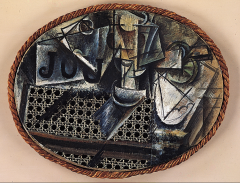
|
Artist: Picasso Title: Still Life with Chair Caning Year: 1912 Medium: oil and oilcloth on canvas -synthetic cubism: real objects in the world and assembling them in new ways -3D work -oilcloth applied -symbol of something that isn't there but is there in out imagination -the cloth is real but the printing is not -moves between what is real and what is nt -"JOU" reference to cafe culture: journal, jouer (to play), jouier (to take pleasure) indicating that this illusion is also a game -depicts objects scattered across a café table -he did surround his painting with actual rope, in ironic imitation of a traditional gold frame. |
|
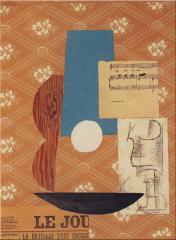
|
Artist: Picasso Title: Guitar and Wine Glass Year: 1912 Medium: pasted paper, gouache,and charcoal -a decorative wallpaper establishes the background for his still life -actually painting a simulated wood-grain pattern on paper, which he then cut out and inserted into his composition as part of the guitar. But the instrument is incomplete; we must construct its shape by decoding the signs the artist provides, such as a section of blue paper for the bridge and a white disk for the sound hole. -Synthetic Cubist pictures are less descriptive of external reality, for they are generally assembled with flat, abstracted forms that have little representational value until they are assigned one within the composition. For example, the bowl-shaped black form is ambiguous, but once inserted in the composition, it stands for part of a guitar. -topical news reference/also jouer to play once again "the battle is engaged" a playful challenge to Braque |
|

|
Artist: Picasso Title: Card Player Year: 1913 Medium: oil on canvas -flat, clearly differentiated shapes in bright and varied color. -Picasso emulates in oil the pasted forms of collage and papiers collés by partially obscuring with a succeeding layer of paint each of the flat shapes that make up the figure. -We can make out a mustachioed card player seated at a wooden table, indicated by the faux bois pattern, on which are three playing cards. |
|
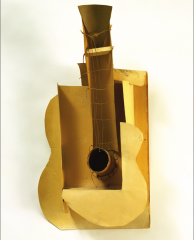
|
Artist: Picasso Title: Maquette for Guitar Year: 1912 Medium: cardboard, string, wire -guitar made from sheet metal -use of an industrial material such as sheet metal was highly unorthodox -the body of the cardboard guitar has largely been cut away. Volume is expressed as a series of flat and projecting planes, resulting in a quality of transparency previously alien to sculpture. -Picasso made the guitar sound hole, a void in a real instrument, as a projecting cylinder, just as he designed the neck as a concavity. |
|
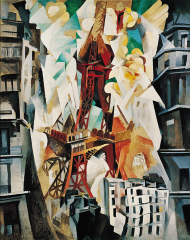
|
Artist: Delaunay Title: Champs de Mars or The Red Tower Year: 1911 Medium: oil on canvas - The painting is the in the style of Orphism, which is distorting objects through Cubist angles (abstraction) and bright, uplifting colors. -The Eiffel Tower is shattered into different planes that are twisted, tilted, and more curvilinear than the actual Tower is. The structure is deep red and is surrounded by bright blue and white fields of color that look like wings or clouds; this praises the ingenuity and industrial aspect of the Tower. -The colors also draw the eye to the center of the painting and create a vibrating, modern energy like that of a bustling city. - dark, cubist buildings that frame the central Tower and seem to close in around it; it’s almost as if the viewer is seeing the Tower through a faceless, skyscraper jungle. The dark colors of the buildings contrast with the brilliance of the central image, and the smaller buildings in the foreground are meant to emphasize the height and monumentality of the Tower as well. -dynamism of modern life into this image by employing multiple viewpoints, rhythmic fragmentation of form, and strong color contrasts. -Delaunay accented the structure’s towering presence by framing it with tall buildings and placing smaller, shorter buildings, seen from above, at its base. -The top of the tower seems to soar, its massive structure augmented by winglike clouds and patches of light-filled sky. |
|
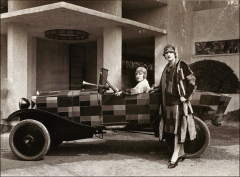
|
Artist: Delaunay Title: “Simultaneist”Clothing Designs and“Simultaneist”Citroen Year: 1925 Medium: photograph -dress next to a car she designed -geometric shapes and slivers of coloured fabric accentuated the sway and movement of the body. -Sonia Delaunay explored the dynamic interaction of brilliant color harmonies. -use of colour, which Sonia described as "the skin of the world." Influenced by the brilliant palettes of the Fauves, but with a complete disinterest in decoration -seeing colours as having independent lives acquired when liberated from subject matter or combined with other colours. -rhythmic relationship between colours in her fabrications but also the reasons behind the move towards ready-to-wear and freedom of movement |
|
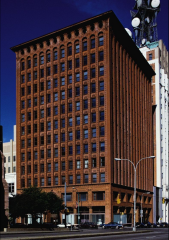
|
Artist: Sullivan Title: Guaranty Trust Building Year: 1894-95 Place: Buffalo, New York -emphasizing verticality, with the result that the piers separating the windows of the top ten stories of the twelve-story structure are uninterrupted through most of the building’s height. -accentuated the individual layers with ornamented bands under the windows, as well as throughout the attic story, and crowned the building with a projecting cornice that brings the structure back to the horizontal. -ornament covers the upper part of the structure in a light, overall pattern, helping to unify the façade while also emphasizing the nature of the terracotta sheathing over the metal skeleton as a weightless, decorative surface, rather than a weight-bearing element. -lots of glass -inner structure is all steel -visually and physically lighter -vertically emphasized by uninterrupted pillars |
|
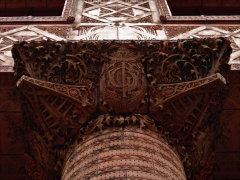
|
Artist: Sullivan Title: Guaranty Trust Building (Detail of Column Capital) Year: 1894-95 Place: Buffalo, New York -highly ornamented with terra cotta -synthesis of modern technology/aesthetic with one foot in the old decorative style |
|
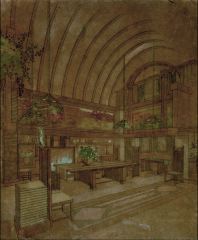
|
Artist: Wright Title: Renderingof Interior,Dana House Year: 1902 Medium: ink on paper -designed every inch, furniture included -vaulted ceiling -vertical but with strong horizontal axis -all designed as one aesthetic whole |
|
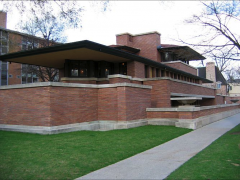
|
Artist: Wright Title: Robie House Year: 1909 Place: Chicago, IL -meant to be considered as a structural whole -flat/long like midwestern openness -interior/exterior flow -hearth/heart (fireplace @ center) -protective and sheltering |
|
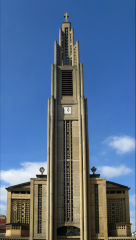
|
Artist: Perret Title: Churchof Notre Dame Year: 1922-23 Place: LeRaincy, France -thin piers, reinforced concrete, walls of stained glass -the simple form of the Early Christian basilica—a long rectangle with only a slightly curving apse, a broad, low-arched nave, and side aisles just indicated by comparably low transverse arches. |
|

|
Artist: Perret Title: Church of Notre Dame (Interior East, West) Year: 1922-23 Place: Le Raincy, France -Construction in reinforced concrete permitted the complete elimination of structural walls. The roof rests entirely on widely spaced slender columns, and the walls are simply constructed of stained glass |

